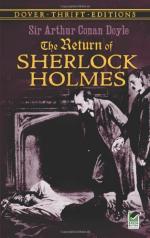“I was a fool not to call you in at the time Mr. Holmes. However, that’s past praying for now. Yes, there were several objects in the room which called for special attention. One was the harpoon with which the deed was committed. It had been snatched down from a rack on the wall. Two others remained there, and there was a vacant place for the third. On the stock was engraved ‘SS. Sea Unicorn, Dundee.’ This seemed to establish that the crime had been done in a moment of fury, and that the murderer had seized the first weapon which came in his way. The fact that the crime was committed at two in the morning, and yet Peter Carey was fully dressed, suggested that he had an appointment with the murderer, which is borne out by the fact that a bottle of rum and two dirty glasses stood upon the table.”
“Yes,” said Holmes; “I think that both inferences are permissible. Was there any other spirit but rum in the room?”
“Yes, there was a tantalus containing brandy and whisky on the sea-chest. It is of no importance to us, however, since the decanters were full, and it had therefore not been used.”
“For all that, its presence has some significance,” said Holmes. “However, let us hear some more about the objects which do seem to you to bear upon the case.”
“There was this tobacco-pouch upon the table.”
“What part of the table?”
“It lay in the middle. It was of coarse sealskin—the straight-haired skin, with a leather thong to bind it. Inside was ‘P.C.’ on the flap. There was half an ounce of strong ship’s tobacco in it.”
“Excellent! What more?”
Stanley Hopkins drew from his pocket a drab-covered notebook. The outside was rough and worn, the leaves discoloured. On the first page were written the initials “J.H.N.” and the date “1883.” Holmes laid it on the table and examined it in his minute way, while Hopkins and I gazed over each shoulder. On the second page were the printed letters “C.P.R.,” and then came several sheets of numbers. Another heading was “Argentine,” another “Costa Rica,” and another “San Paulo,” each with pages of signs and figures after it.
“What do you make of these?” asked Holmes.
“They appear to be lists of Stock Exchange securities. I thought that ‘J.H.N.’ were the initials of a broker, and that ‘C.P.R.’ may have been his client.”
“Try Canadian Pacific Railway,” said Holmes.
Stanley Hopkins swore between his teeth, and struck his thigh with his clenched hand.
“What a fool I have been!” he cried. “Of course, it is as you say. Then ‘J.H.N.’ are the only initials we have to solve. I have already examined the old Stock Exchange lists, and I can find no one in 1883, either in the house or among the outside brokers, whose initials correspond with these. Yet I feel that the clue is the most important one that I hold. You will admit, Mr. Holmes, that there is a possibility that these initials are those of the second person who was present—in other words, of the murderer. I would also urge that the introduction into the case of a document relating to large masses of valuable securities gives us for the first time some indication of a motive for the crime.”




